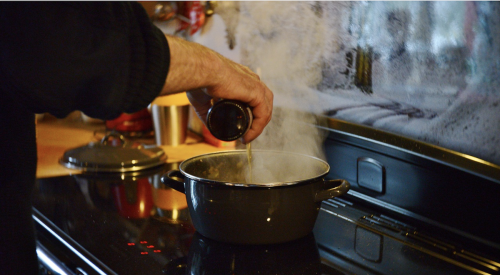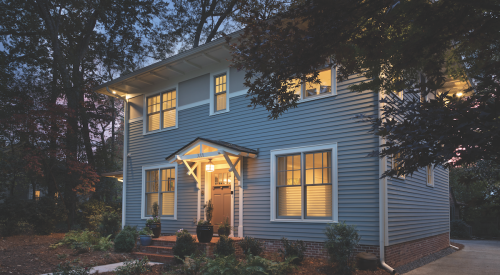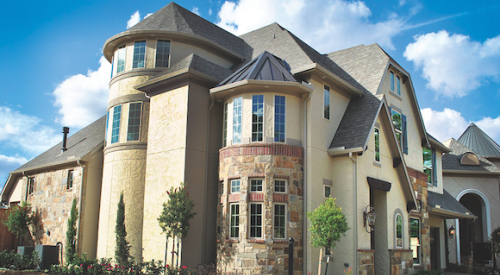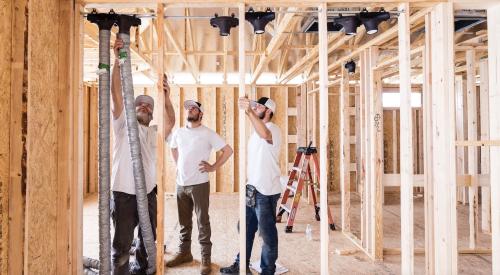Officially launched by President Clinton on May 4, 1998, the Partnership for Advancing Technology in Housing, or PATH, is primarily intended to act as a central source of information for the housing industry and its suppliers. It addresses a diverse spectrum of housing issues, from reducing construction-related injuries to decreasing housing maintenance costs. Home energy efficiency is a central aspect of the initiative, but PATH technology must also meet quality, durability and affordability guidelines.
| Prototype by Beazer Homes in California’s Simi Valley is one of the first houses to be built under the PATH program. |
One of the first prototypes to be built under the PATH program was unveiled in July at Heather Hills, a community by Beazer Homes USA. Previously involved with an energy-efficient building program in Texas, the Atlanta-based firm was eager to listen when Southern California Edison suggested a PATH project in California’s Simi Valley.
"We were excited about the program," says Gary Gafford, Beazer’s northern region construction manager. "We see the PATH initiative as a win-win proposition for both the builder and the consumer."
PATH is a diverse coalition of federal agencies, such as the U.S. Department of Energy, Department of Defense and Department of Agriculture, and major manufacturers such as CertainTeed, Kohler, Lucent Technologies, DuPont and Louisiana-Pacific. The program’s goal is to bring attention to promising but little-known technology, and to reduce the lead time between product development and its introduction to the marketplace.
Later, as more builders get involved in the PATH program, they will provide feedback about what works best for them. Some recommendations, such as solar panel installations, are now hampered by the high cost of existing technology. But other suggestions are currently more affordable to home buyers, and thus more attractive to home builders.
| To improve the HVAC system’s efficiency, all ductwork was installed within the house’s thermal envelope rather than in the attic. Prototype house is completely wired with Lucent’s Home Star cable, which allows expanded band width for Internet connections. |
Building the Heather Hills PATH home allowed Beazer to decide whether the PATH program makes financial sense. One appealing aspect was its conservative use of innovation.
"The beauty of this program is that we used readily available, market-ready technology. In most cases, the changes we made were relatively simple to incorporate," says Gafford.
Beazer adapted an existing floor plan for the PATH prototype. Two virtually identical homes with similar exposures were built, one of them incorporating PATH features. This gave Beazer an accurate control model during construction. It will also provide Edison with comparison data on energy usage and savings during a planned one-year monitoring period.
Initial results are impressive. Gafford cites Department of Energy testing on the PATH home that showed a 30% increase in energy efficiency. The changes Beazer made in its prototype were minor, such as substituting low-E glass for standard glazing and using R-30 attic insulation instead of R-19. Gafford admits these measures added about $1100 in material costs, but enhancing thermal efficiency required no new skills or training: "Beazer is used to building air-tight homes, so this part of the job had no learning curve."
Gafford adds that savings elsewhere could help balance the higher material costs. By increasing the home’s thermal efficiency, Beazer was able to downsize the HVAC system. "We went from a 7-ton, gas-forced-air unit to a smaller, more efficient 41/2-ton electrical heat pump system."
| Due to increased thermal efficiency, Beazer was able to downsize the HVAC system to a 4-1/2-ton electrical heat pump. Supplied by Carrier, the system uses a refrigerant called Puront. Photography by Jon Reeves, Southern California Edison |
Supplied by Carrier, this heat pump relies on a relatively costly refrigerant known as Puront. Gafford says this choice raised the home’s cost by $3500, with an HVAC payback period of about eight years. Had Beazer used a different heating and cooling system without Puront, he calculates the payback at less than two years.
The PATH HVAC plant and ductwork were installed within the conditioned part of the envelope, rather than in a non-conditioned attic as is the norm. The relocation is typical of PATH’s effective simplicity. "By moving the heating and cooling equipment into the house, we were able to get a substantial increase in the unit’s efficiency," he says.
Solar Fan Keeps Attic Cool
Gafford had reservations about the optional rooftop solar water pre-heater. His goal, as a builder, is to make a watertight roof, and the solar collector, with its additional roof penetrations, makes that job harder. He was thoroughly impressed, however, with the solar-powered attic vent fan.
"The self-contained, thermostat-controlled fan automatically responds to rising attic temperatures," Gafford says. "We’ve even been approached by [community] residents who want one installed in their homes."
Several PATH improvements have greater direct appeal to home buyers than home builders, such as high-efficiency lighting and appliances, low-emission interior paints and an electric car charging station. Some features that Beazer installed appeal only to the consumer, such as the Trext decking with its low maintenance and long life. Beazer does expect to benefit from these features through enhanced curb appeal and faster sales.
Labor costs associated with PATH were obviously of concern to Beazer, which closely monitored that aspect of the project.
"The PATH project gave us the opportunity to prototype a house under the conditions in which we usually build," says Gafford. PATH’s net impact on the building’s labor burden was near zero, a fact he attributes to the system’s stark simplicity.
At press time, it was too soon to gauge consumer reaction to the PATH home, but Beazer is anticipating a profitable response. The company’s goal was not to build an ecologically responsible home for its own sake. According to Gafford, "Energy efficiency was important, but the PATH home offers buyers a payback. We’re hoping to hear that consumers see the value in this approach, and that they’re willing to pay a small upcharge to get a 30% to 35% reduction in their utility bills."
Leland Edward Stone writes frequently on business and technology for the construction industry. His e-mail address is maydole@aol.com.












